Getting there
I took the first bus from Brewood to Wolverhampton and caught the busy 08:11 Arriva Trains Wales to Birmingham International, getting off at Birmingham New Street. Having some time in hand, I toured the Grand Central shopping area, amazed at the range of food outlets well-patronised by people taking breakfast - coffee shops, juice bars, pizza places, sushi bars, Mexican food, even Korean Street Food! I talked about my reaction to Birmingam's Grand Central in the earlier post here.

Grand Central, Birmingham New Street: Atrium showing retail outlets at both Concourse Level and around the Gallery.
I exited to Stephenson Place to see the temporary terminus of the 'Midland Metro' now that the extension from the original terminus at Snow Hill along Corporation Street to New Street station is, belatedly, in use. A further extension, due to open in 2019, will pass the Town Hall and reach Centenary Square. The rolling stock comprises 21 units of the 'Urbos 3' five-section articulated design built by CAF in Spain. See the Wikipedia article here.
Returning to the station, I was just in time to catch the next Class 323 Electric Multiple Unit on the Cross-City service. The service was taken over by 'West Midlands Trains' on 10-Dec-2017 (as I mentioned in the earlier post A Trip to Merseyside) but, externally, the former 'London Midland' livery is still carried. The Class 323 were built by Hunslet between 1992 and 1995 and, under our crazy arrangements for privatising railways, the trainsets are now owned by Porterbrook which is a 'ROSCO' (rolling stock company). There's a Porterbrook data sheet on the Class 323 here.
The journey only took a few minutes and the University of Birmingham has its own station called, with admirable clarity, 'University' (although the station is equally handy for the huge Queen Elizabeth Hospital). Since I walk slowly these days, it took me 15 or 20 minutes to walk across the large university campus to the venue. The focal point of the university remains the original D-plan grouping of red brick buildings designed by Sir Aston Webb and Ingress Bell built between 1900 and 1909 with its campanile clock tower of tapering square section with a corbelled top stage and lantern, called the 'Joseph Chamberlain Memorial Clock Tower', the 'Chamberlain Clock' or simply 'Old Joe' in honour of the university's first chancellor. There's more on the clock tower in the Wikipedia article here.
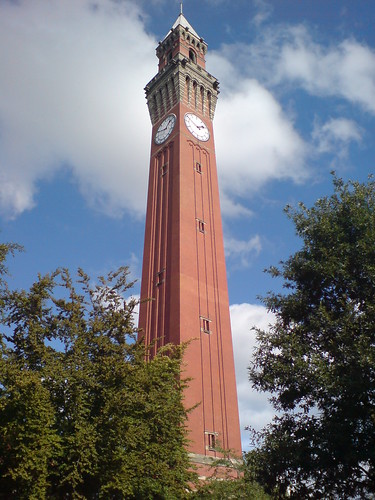
Joseph Chamberlain Memorial Clock, University of Birmingham (Photo: Tomsega, Public Domain).
The initial, unified group of buildings is now surrounded by numerous more modern structures, each of a completely different design reflecting tastes at the time of building.
The venue

Rail Industry Information Day, 2018: Gisbert Kapp Building, University of Birmingham.
The venue was the School of Electronic, Electrical and Control Engineering located in the Gisbert Kapp Building. I had to look up Gisbert Kapp, an Austrian/English electrical engineer born 1852 who held the first Chair of Electrical Engineering at the University of Birmingham from 1904 until his death in 1922. There's a detailed profile in Grace's Guide here.

Gisbert Kapp in 1922 (Photo: Grace's Guide).
The Sponsor
The event was sponsored by the Rail Safety and Standards Board (RSSB), created in 2003 following Railtrack's demise as an independent not-for-profit company limited by guarantee, with a remit to encourage rail research and innovation and creating better links between universities and the rail industry. The University of Birmingham is home to the Birmingham Centre for Railway Research and Education (BCRRE), described here.
The railway industry is now littered with a bewildering array of initiatives and acronyms whose initials were freely used throughout the proceedings. Here are a few:-
RSG (Rail Supply Group)The event
RDG (Rail Delivery Group)
TLG (Technical Leadership Group)
UKRRIN (UK Rail Research and Innovation Network)
Registration took place on the first floor where refreshments were available in 'The Link', a student Open Learning area closed to students for the day.
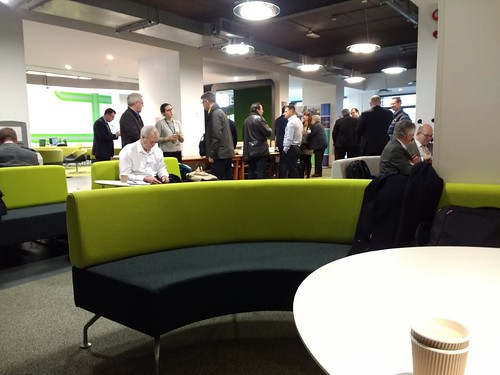 Rail Industry Information Day, 2018: Refreshments in 'The Link'.
Rail Industry Information Day, 2018: Refreshments in 'The Link'.
At 10:15 we were invited to troop to a large, modern lecture theatre on the ground floor. There were almost 100 attendees, over half from the rail industry. Martin Brennan, Head of European Programmes at RSSB, said that the day would review the Horizon 2020 and Shift2Rail Work Programmes and Collaboration funding opportunities available within 80 billion Euros of funding being provided by the European Union (EU) between 2014 and 2020. More information is available here. Within Horizon 2020, Shift2Rail (S2R) is dedicated to railway research, with more information here.
Professor Clive Roberts [Professor of Railway Systems at the University of Birmingham and Director of the Birmingham Centre for Railway Research and Education (BCRRE)] then gave a "virtual tour" of the Railway Centre of BCRRE, one of three centres in the United Kingdom supporting new innovation in rail transport and part of UKRRIN.
Next, Carlo Borghini who is Executive Director of the Shift2Rail Joint Undertaking updated the meeting on the current programme status and future opportunities.
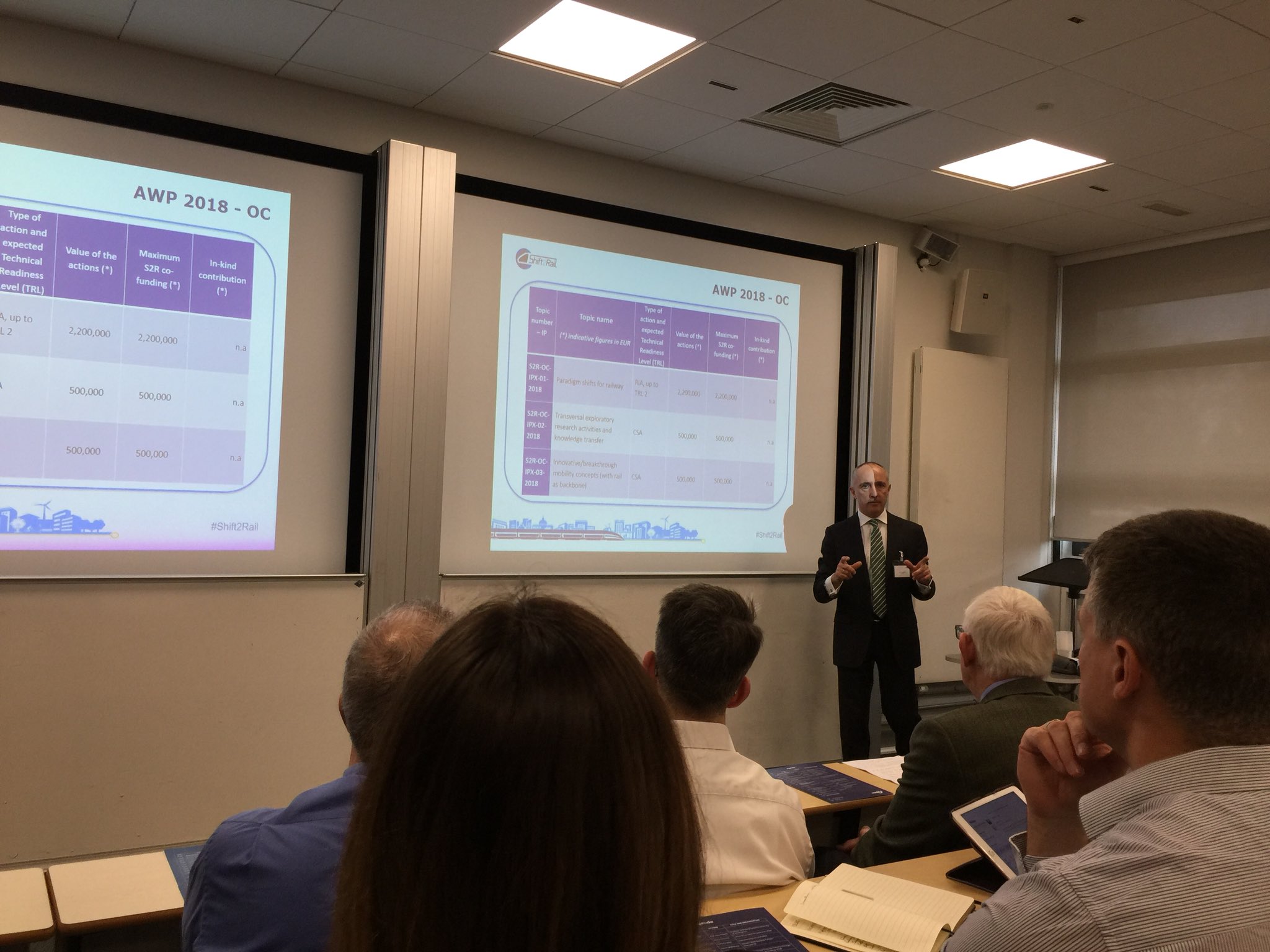
Carlo Borghini addressing Rail Industry Information Day (Photo: Professor Clive Roberts via Twitter).
Louise Mothersole (Horizon 2020 UK National Contact Point for Transport at Innovate UK) explained that the decision of the United Kingdom to leave the European Union did not affect the eligibility of United Kingdom firms seeking to participate in Horizon 2020.
After a coffee break held in The Link, James Hardy talked about RSSB's Rail Technical Strategy. This was followed by a series of 2-minute 'Elevator Pitches' from 12 speakers, after which a buffet lunch was served in 'The Link'.
At 13:45, Martin Brennan described the European Rail Research Advisory Council (ERRAC) which was set up in 2001 to "promote an holistic vision of the European Rail system with all stakeholders" before introducing Professor Simon Iwnicki (Professor of Railway Engineering and Director of the Institute of Railway Research - Huddersfield University) who spoke about participation in Shift2Rail 'Open Call' projects.
Next, Professor Clive Roberts spoke about the S-CODE Project which aims to investigate radically different technology concepts that can be integrated to achieve significantly improved performance for railway Switches and Crossings emphasising successful techniques used in planning this type of project.
A concise explanation of the various funding opportunities under Horizon 2020 and Shift2Rail was given by Louise Mothersole, with an invitation for applicants to contact the National Contact Point for support.
RSSB, in conjunction with Rail Research UK Association, has completed its Rail Technical Strategy Capability Development Plan (RTS CDP). The plan is divided into 12 'Work Packages' to which 'Work Package Owners' have been allocated.

A graphic representing the 12 Work Packages.
Finally, two of the Work Package Owners made short presentations:-
Janine Fountain spoke about Package 02 - Minimal disruption to train serviceThis concluded an interesting day which had given many useful suggestions to prospective applicants.
Karl Butler-Garnham spoke about Package 04 - More value from data
Railway Centre
As originally planned, the day was to have started with a physical tour of the Railway Centre laboratories but the large number of attendees precluded this, hence the "virtual tour" mentioned above. However, a small group of attendees stayed behind for a tour offered by Doctor Edd Stewart (Lecturer in digital logic and microprocessor systems who also leads on various research projects). An idea of the Research Capability offered by BCRRE can be gained from the website here. Some of the highlights of the tour are outlined below.
A room containing a 14-foot diameter horizontal wheel with a circle of rail on top can be rotated by a 30 kW electric motor to give the effect of a train travelling at 80 km/hour. Chillers can produce freezing conditions in the room, allowing research into railhead de-icing for railways.
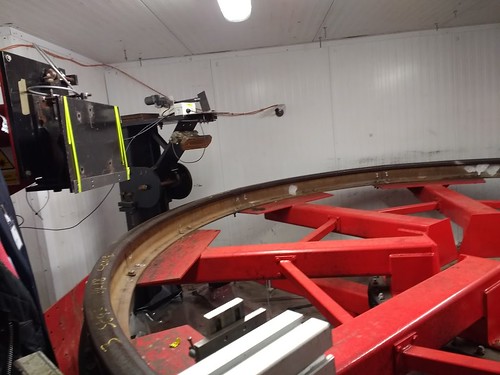
Rail Industry Information Day, 2018: Railhead testing rig.
A well-equipped Railway Control and Operations Simulation room allows research into the next generation of railway traffic management systems.
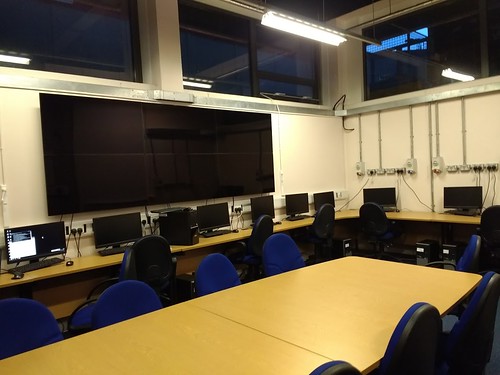
Railway Control and Operations Simulation Room.
In another area, we saw various types of prototype condition monitoring equipment for rolling stock.
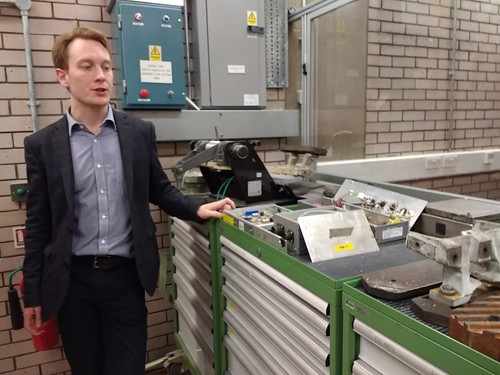
Rail Industry Information Day, 2018: Dr. Edd Stewart with prototype condition monitoring equipment.
We saw the laboratory-based test facility for evaluating and characterising pantograph dynamic loading performance.
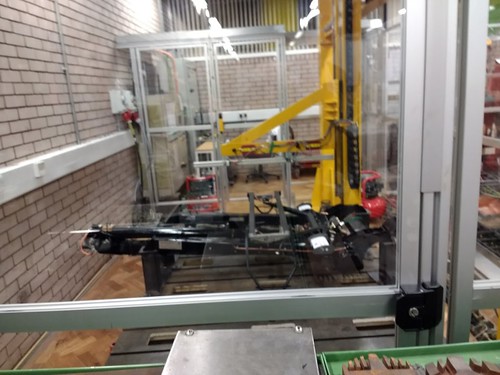
Rail Industry Information Day, 2018: Pantograph test rig.
Nearby, there was a robotic inspection cell for use with railway vehicle wheelsets.
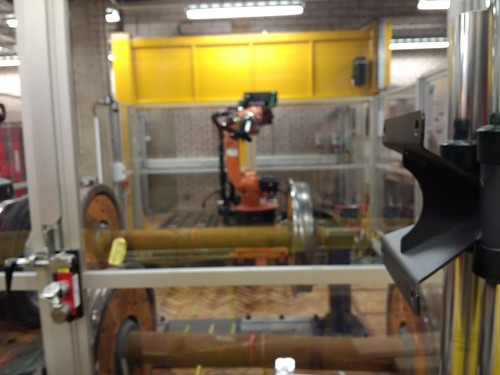
Robotic inspection cell for use with railway vehicle wheelsets.
Another climate chamber held the 'sharp end' of a set of points, allowing the evaluation of point machine performance under varying weather conditions. There was also a small 4-wheel inspection trolley in this chamber, fitted with a robotic arm which can examine the rail head.
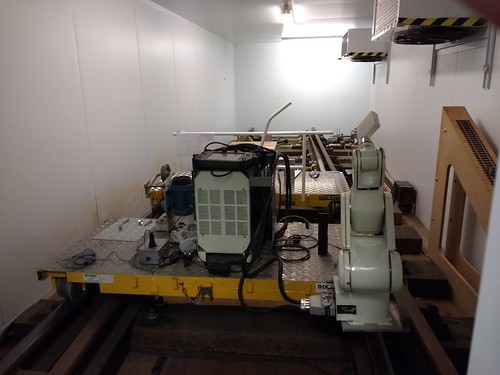
Rail Industry Information Day, 2018: Rail switch test chamber.
A large Motor Generator Set with a programmable load is available for Power Systems and Energy Use research.

Rail Industry Information Day, 2018: Motor Generator Set with a programmable load for Power Systems research.
On our way out, we passed a full-sized cab, which I decided was a Class 717 cab. The Class 700 'Desiro City' are already in use on British Rail. The Class 717 is a variant with end doors for use on the Northern City Line which allows passengers to be evacuated via the Moorgate Tunnel, as is possible with the existing 40-year old Class 313.
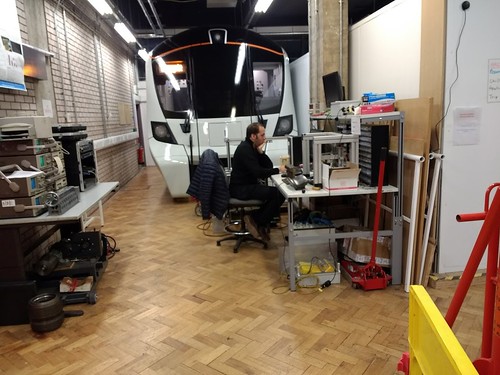
Rail Industry Information Day, 2018: Class 717 cab.
Getting back
It only remained to return home by walking back across the darkening Campus, catching a busy Cross-City service to Birmingham New Street, changing to a standing room only Arriva Trains Wales service as far as Wolverhampton and then getting a taxi home (our last bus from Wolverhampton is 17:10!)
Related posts on this website
Rail Research UK Association Annual Conference 2017.
Grand Central and Birmingham New Street Station.
My photograph albums
Where necessary, clicking on an image above will display an 'uncropped' view or, alternately, pictures may be selected, viewed or downloaded, in various sizes, from the albums listed:-
Rail Industry Information Day.
